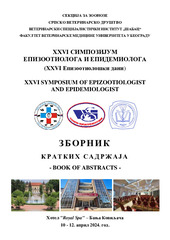Приказ основних података о документу
Kretanje nalaza salmonela kod živine na beogradskom epizootiološkom području u periodu 2017 - 2024. godine
Trends in salmonella poultry findings in Belgrade epizoological area during 2017 - 2024 period
| dc.creator | Zdravković, Nemanja | |
| dc.creator | Radanović, Oliver | |
| dc.creator | Spalević, Ljiljana | |
| dc.creator | Maletić, Jelena | |
| dc.creator | Ninković, Milan | |
| dc.creator | Marjanović, Đorđe | |
| dc.creator | Medić, Dragana | |
| dc.date.accessioned | 2024-04-26T06:50:32Z | |
| dc.date.available | 2024-04-26T06:50:32Z | |
| dc.date.issued | 2024 | |
| dc.identifier.isbn | 978-86-83115-52-5 | |
| dc.identifier.uri | https://vet-erinar.vet.bg.ac.rs/handle/123456789/3855 | |
| dc.description.abstract | Салмонелозе живине су скуп болести коју узрокују Грам-негативне бактерије из породице Enterobacteriaceae и врсте Salmonella enterica. Од око 2500 описаних серотипова ове врсте, око 10 % изоловано из живине. Посебан значај салмонеле добијају својим карактером, јер поједини серотипови могу угрозити здравље људи, доводећи до гастроинтестиналних токсоинфекција услед конзумације живинских производа. Описан је вертикални пренос трансоваријалним путем на потомство, али и хоризонтални и то најчешће излучивањем у фецесу. Као највећа опасност по људско здравље, издваја се налаз салмонела у месу, јајима или на љусци живинских јаја. Поједина живина може бити заражена салмонелама а да не показује клиничке знаке болести, али чине значајан извор ширења заразе, док клинички симптоми варирају од дигестивних проблема (бели пролив, маладсорпција), до бактеријемије и угинућа. Циљ овог испитивања је био ретроспективно прикаже присуство бактерија рода Salmonella enterica subspecies enterica разних серотопова, код живине на београдском епизоотиолошком подручју. Испитивањем су обухваћени узорци: ембрионирана јаја, лешеви једнодневних пилића, фецес бројлера и носиља, у последњих шест година. Салмонеле су изоловане стандардним микробиолошким методама праћено серолошком типизацијом. У испитиваном број позитивних узорака салмонела живине се кретао од 879 што је забележено у 2017. преко 65 2018.године, док су значајно нижи налази забележени током 2016. и 2021. године са 7 позитивних узорака, док је 2022. године забележено 4, а током 2023. године 2 позитивна узорка. Изоловани серотипови у наведеном периоду су S. Enteritidis, S. Infantis, S. Mbandaka, S. Senftenberg, S. Typhimurium, S. Agona, S. Taksony и S. Shiongwe. Највише позитивних узорака је установљено у фецесу носиља, затим фецесу бројлера, лешевима једнодневних пилића и ембрионираним јајима. Потпуно искорењивање салмонела из производње је тежак циљ због присуства великог броја серотипова салмонела и различитих извора заразе, али је зато потребно донети правилну стратегију контроле за спречавање ризика од контаминације. Превенција је најбољи алат за контролу салмонела: хигијена, биосигурност и тамо где је изводљиво - вакцинација. Велика је одговорност на узгајивачима на примени постојећих и унапређењу нових стандарда. | sr |
| dc.description.abstract | Poultry salmonellosеs are group of diseases caused by Gram-negative bacteria from the Enterobacteriaceae and species Salmonella enterica. Of about 2500 serotypes of this species, about 10% are isolated from poultry. Special significance of salmonella comes from their character, as some serotypes can endanger human health leading to gastrointestinal toxin infections due to the consumption of poultry products. Vertical transmission is described by transovarian route to offspring, but also horizontal transmission, the most often by faecal secretion. The greatest risk for human well-being is the finding of Salmonella in poultry meat, in the eggs and on the eggshells. Some poultry can be infected with Salmonella without showing any clinical signs of the disease, but nevertheless being a significant source of infection, while clinical symptoms range from digestive problems (white diarrhoea, malabsorption), to bacteraemia and death. The aim of this paper is to retrospective presence of bacteria Salmonella enterica subspecies enterica in poultry in the Belgrade epizootiological area. Observation included samples of: embryonic eggs, day-old chicken cadavers, broiler and laying hens faeces samples investigated in six-year period. Salmonellae were isolated by standard microbiological methods followed by serological typing. In the examined number of positive samples of poultry salmonella ranged from 879 recorded in 2017 to 65 in 2018, while significantly lower findings were recorded in 2016 and 2021 with 7 positive samples, while 4 were recorded in 2022, and during 2023, 2 positive samples. The serotypes isolated in the mentioned period are S. Enteritidis, S. Infantis, S. Mbandaka, S. Senftenberg, S. Typhimurium, S. Agona, S. Taksony and S. Shiongwe. The most positive samples were found in the feces of laying hens, followed by the feces of broilers, carcasses of one-day-old chickens and embryonated eggs. Complete eradication of Salmonella from production is a difficult goal because of the presence of a large number of Salmonella serotypes and various sources of infection, but a proper control strategy must therefore be executed to prevent the risk of contamination. Prevention is the best tool for controlling Salmonella: hygiene, biosecurity and vaccination. It is a great responsibility of the breeders to apply the existing standards and to improve the new ones. | sr |
| dc.language.iso | sr | sr |
| dc.language.iso | en | sr |
| dc.publisher | Beograd : Srpsko veterinarsko društvo, Sekcija za zoonoze | sr |
| dc.relation | info:eu-repo/grantAgreement/MESTD/inst-2020/200030/RS// | sr |
| dc.rights | openAccess | sr |
| dc.rights.uri | https://creativecommons.org/licenses/by/4.0/ | |
| dc.source | XXVI Simpozijum epizootiologa i epidemiologa (XXVI Epizootiološki dani), Banja Koviljača, 10 - 12. april 2024 | sr |
| dc.subject | Enterica | sr |
| dc.subject | Salmonella | sr |
| dc.subject | микробиологија | sr |
| dc.subject | преваленција | sr |
| dc.subject | microbiology, | sr |
| dc.subject | prevalence | sr |
| dc.title | Kretanje nalaza salmonela kod živine na beogradskom epizootiološkom području u periodu 2017 - 2024. godine | sr |
| dc.title | Trends in salmonella poultry findings in Belgrade epizoological area during 2017 - 2024 period | sr |
| dc.type | conferenceObject | sr |
| dc.rights.license | BY | sr |
| dc.citation.spage | 170 | |
| dc.citation.epage | 171 | |
| dc.description.other | Zbornik kratkih sadržaja | sr |
| dc.identifier.fulltext | http://veterinar.vet.bg.ac.rs/bitstream/id/11540/bitstream_11540.pdf | |
| dc.identifier.rcub | https://hdl.handle.net/21.15107/rcub_veterinar_3855 | |
| dc.type.version | publishedVersion | sr |

